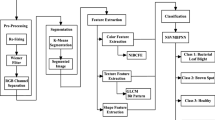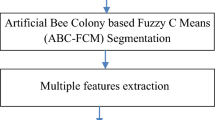Abstract
Rice production is hugely affected by the rice blast disease among all the diseases. This work’s proposed a Modified Artificial Bee Colony Optimization Algorithm based Incremental classifier Design which typically considers the benchmark solution during prediction. But, pre-processes rely on the window size to the incremental classifier taking a greater amount of training time if a large sized dataset is considered. Therefore, this research work presents a smart segmentation and hybrid machine learning based classification for effectively predicting the rice disease. This technique combines pre-processing, segmentation, feature extraction/selection, and finally classification. Initially, the Synthetic Minority Oversampling Technique based preprocessing is introduced for data normalization process. Secondly, Modified Feature weighted Fuzzy Clustering based segmentation is used for performing the segmentation efficiently. Then the Feature extraction is done using Principal component Analysis to enhance the classifier performance. Linear Discriminant Analysis performs the feature selection. Finally, Enhanced Recurrent Neural Network is combined with Support Vector Machine called hybrid classification model which is intended to improve prediction performance. Accuracy, recall, precision, timing, and F-measure metrics are used to gauge the effectiveness of the outcomes. The simulation results show that the suggested approach outperforms the current classifiers in terms of performance.






Similar content being viewed by others
References
Ahmed K, Shahidi TR, Alam SMI, Momen S (2019) Rice leaf disease detection using machine learning techniques. In: 2019 international conference on sustainable technologies for industry 4.0 (STI). IEEE, pp 1–5
Al-Amin M, Karim DZ, Bushra TA (2019). Prediction of rice disease from leaves using deep convolution neural network towards a digital agricultural system. In: 2019 22nd international conference on computer and information technology (ICCIT). IEEE, pp 1–5
Bari BS, Islam MN, Rashid M, Hasan MJ, Razman MAM, Musa RM, Majeed APA (2021) A real-time approach of diagnosing rice leaf disease using deep learning-based faster R-CNN framework. PeerJ Comput Sci 7:e432
Bashir K, Rehman M, Bari M (2019) Detection and classification of rice diseases: an automated approach using textural features. Mehran Univ Res J Eng Technol 38(1):239–250
Bera T, Das A, Sil J, Das AK (2019) A survey on rice plant disease identification using image processing and data mining techniques. Emerging technologies in data mining and information security. Springer, Singapore, pp 365–376
Chawla NV, Bowyer KW, Hall LO, Kegelmeyer WP (2002) SMOTE: synthetic minority over-sampling technique. J Artif Intell Res 16:321–357
Daniya T, Vigneshwari S (2019) A review on machine learning techniques for rice plant disease detection in agricultural research. System 28(13):49–62
Du H, Wang J, Hu Z, Yao X, Zhang X (2008) Prediction of fungicidal activities of rice blast disease based on least-squares support vector machines and project pursuit regression. J Agric Food Chem 56(22):10785–10792
Ghosal S, Sarkar K (2020) Rice leaf diseases classification using CNN with transfer learning. In 2020 IEEE Calcutta conference (CALCON). IEEE, pp 230–236
Haider W, Rehman AU, Maqsood A, Javed SZ (2020) Crop disease diagnosis using deep learning models. In: 2020 global conference on wireless and optical technologies (GCWOT). IEEE, pp 1–6
Hsieh JY, Huang W, Yang HT, Lin CC, Fan YC, Chen H (2019) Building the rice blast disease prediction model based on machine learning and neural networks. Manchester, EasyChair
Kamrul MH, Paul P, Rahman M (2019). Machine vision based rice disease recognition by deep learning. In: 2019 22nd international conference on computer and information technology (ICCIT). IEEE, pp 1–6
Kaundal R, Kapoor AS, Raghava GP (2006) Machine learning techniques in disease forecasting: a case study on rice blast prediction. BMC Bioinform 7(1):1–16
Kim KH, Cho J, Lee YH, Lee WS (2015) Predicting potential epidemics of rice leaf blast and sheath blight in South Korea under the RCP 4.5 and RCP 8.5 climate change scenarios using a rice disease epidemiology model, EPIRICE. Agric for Meteorol 203:191–207
Kim Y, Roh JH, Kim HY (2018) Early forecasting of rice blast disease using long short-term memory recurrent neural networks. Sustainability 10(1):34
Kodama T, Hata Y (2018) Development of classification system of rice disease using artificial intelligence. In: 2018 IEEE international conference on systems, man, and cybernetics (SMC). IEEE, pp 3699–3702
Leung H, Zhu Y, Revilla-Molina I, Fan JX, Chen H, Pangga I, Mew TW (2003) Using genetic diversity to achieve sustainable rice disease management. Plant Dis 87(10):1156–1169
Mique Jr EL, Palaoag TD (2018) Rice pest and disease detection using convolutional neural network. In: Proceedings of the 2018 international conference on information science and system. pp 147–151
Patro S, Sahu KK (2015) Normalization: a preprocessing stage. ar**v preprint ar**v:1503.06462
Ramesh S, Vydeki D (2018) Rice blast disease detection and classification using machine learning algorithm. In: 2018 2nd international conference on micro-electronics and telecommunication engineering (ICMETE). IEEE, pp 255–259
Sengupta S, Das AK (2017) Particle swarm optimization based incremental classifier design for rice disease prediction. Comput Electron Agric 140:443–451
Sethy PK, Barpanda NK, Rath AK, Behera SK (2020) Rice false smut detection based on faster R-CNN. Indones J Electr Eng Comput Sci 19(3):1590–1595
Sharma R, Kukreja V (2021) Rice diseases detection using convolutional neural networks: a survey. In: 2021 international conference on advance computing and innovative technologies in engineering (ICACITE). IEEE, pp 995–1001
Author information
Authors and Affiliations
Corresponding author
Ethics declarations
Conflict of interest
The authors declare that they have no conflict of interest.
Informed consent
Not applicable as no human or animal sample was involved in this study.
Human or animals rights
In our work, no animals or human are involved.
Additional information
Publisher's Note
Springer Nature remains neutral with regard to jurisdictional claims in published maps and institutional affiliations.
Rights and permissions
Springer Nature or its licensor (e.g. a society or other partner) holds exclusive rights to this article under a publishing agreement with the author(s) or other rightsholder(s); author self-archiving of the accepted manuscript version of this article is solely governed by the terms of such publishing agreement and applicable law.
About this article
Cite this article
Senthilkumar, T.P., Prabhusundhar, P. Prediction of rice disease using modified feature weighted fuzzy clustering (MFWFC) based segmentation and hybrid classification model. Int J Syst Assur Eng Manag (2023). https://doi.org/10.1007/s13198-022-01835-7
Received:
Revised:
Accepted:
Published:
DOI: https://doi.org/10.1007/s13198-022-01835-7




